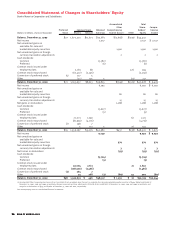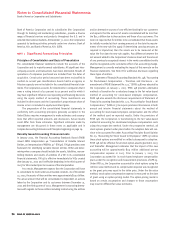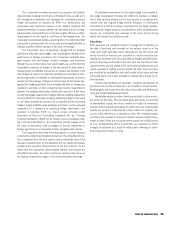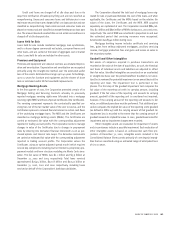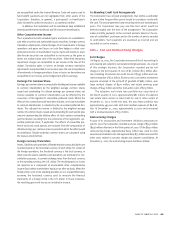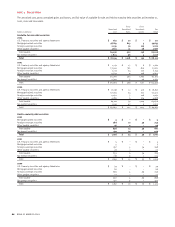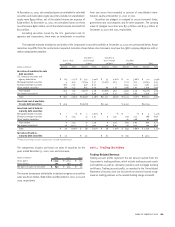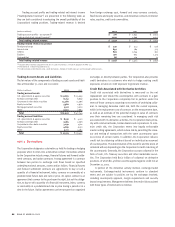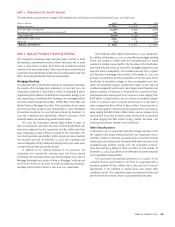Bank of America 2002 Annual Report Download - page 82
Download and view the complete annual report
Please find page 82 of the 2002 Bank of America annual report below. You can navigate through the pages in the report by either clicking on the pages listed below, or by using the keyword search tool below to find specific information within the annual report.
80 BANK OF AMERICA 2002
Loans and Leases
Loans are reported at their outstanding principal balances net of any
unearned income, charge-offs, unamortized deferred fees and costs
on originated loans and premiums or discounts on purchased loans.
Loan origination fees and certain direct origination costs are deferred
and recognized as adjustments to income over the lives of the related
loans. Unearned income, discounts and premiums are amortized to
income using methods that approximate the interest method.
The Corporation provides equipment financing to its customers
through a variety of lease arrangements. Direct financing leases are car-
ried at the aggregate of lease payments receivable plus estimated resid-
ual value of the leased property, less unearned income. Leveraged
leases, which are a form of financing lease, are carried net of non-
recourse debt. Unearned income on leveraged and direct financing
leases is amortized over the lease terms by methods that approxi-
mate the interest method.
Allowance for Credit Losses
The allowance for losses is management’s estimate of probable losses
in the lending portfolios. Additions to the allowance for credit losses are
made by charges to the provision for credit losses. Credit exposures,
excluding derivatives assets, deemed to be uncollectible are charged
against the allowance for credit losses. Recoveries of previously charged
off amounts are credited to the allowance for credit losses.
The Corporation performs periodic and systematic detailed
reviews of its lending portfolios to identify credit risks and to assess the
overall collectibility of those portfolios. The allowance on certain homo-
geneous loan portfolios, which generally consist of consumer loans, is
based on aggregated portfolio segment evaluations generally by prod-
uct type. Loss forecast models are utilized for these segments which
consider a variety of factors including, but not limited to, historical loss
experience, estimated defaults or foreclosures based on portfolio
trends, delinquencies and credit scores. The remaining portfolios are
reviewed on an individual loan basis. Loans subject to individual
reviews are analyzed and segregated by risk according to the
Corporation’s internal risk rating scale. These risk classifications, in
conjunction with an analysis of historical loss experience, current
economic conditions and performance trends within specific portfolio
segments, and any other pertinent information (including individual
valuations on nonperforming loans in accordance with Statement of
Financial Accounting Standards No. 114, “Accounting by Creditors for
Impairment of a Loan,” (SFAS 114)) result in the estimation of the
allowances for credit losses.
If necessary, a specific allowance for credit losses is established
for individual impaired commercial loans. A loan is considered
impaired when, based on current information and events, it is pro-
bable that the Corporation will be unable to collect all amounts due,
including principal and interest, according to the contractual terms of
the agreement. Once a loan has been identified as individually
impaired, management measures impairment in accordance with
SFAS 114. Individually impaired loans are measured based on the
present value of payments expected to be received, observable mar-
ket prices, or for loans that are solely dependent on the collateral for
repayment, the estimated fair value of the collateral. If the recorded
investment in impaired loans exceeds the measure of estimated fair
value, a specific allowance is established as a component of the
allowance for credit losses.
Portions of the allowance for credit losses are allocated to
cover
the estimated probable incurred credit losses in each loan and
lease category based on the results of the Corporation’s detail review
process described above. The allocated portion continues to be
weighted toward the commercial loan portfolio, which reflects a
higher level of nonperforming loans and the potential for higher indi-
vidual losses. The remaining or general portion of the allowance for
credit losses, determined separately from the procedures outlined
above, addresses certain industry and geographic concentrations,
including global economic conditions and binding unfunded commit-
ments, as well as, a component for the margins of imprecision in our
estimation models. Due to the subjectivity involved in the determi-
nation of the general portion of the allowance for credit losses, the
relationship of the general component to the total allowance for
credit losses may fluctuate from period to period. Management evalu-
ates the adequacy of the allowance for credit losses based on the
combined total of the allocated and general components.
Nonperforming Loans
Commercial loans and leases that are past due 90 days or more as to
principal or interest, or where reasonable doubt exists as to timely col-
lection, including loans that are individually identified as being
impaired, are generally classified as nonperforming loans unless well-
secured and in the process of collection. Loans whose contractual
terms have been restructured in a manner which grants a concession to
a borrower experiencing financial difficulties, without compensation on
restructured loans, are classified as nonperforming until the loan is per-
forming for an adequate period of time under the restructured agree-
ment. In situations where the Corporation does not receive adequate
compensation, the restructuring is considered a troubled debt restruc-
turing. Interest accrued but not collected is reversed when a commer-
cial loan is classified as nonperforming. Interest collections on
commercial nonperforming loans and leases for which the ultimate col-
lectibility of principal is uncertain are applied as principal reductions;
otherwise, such collections are credited to income when received.






